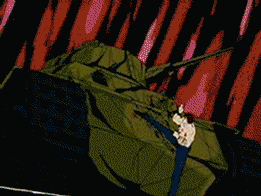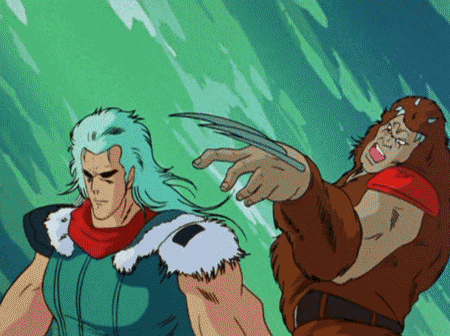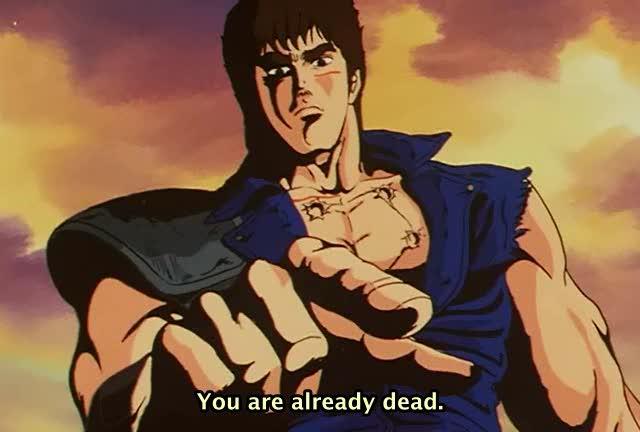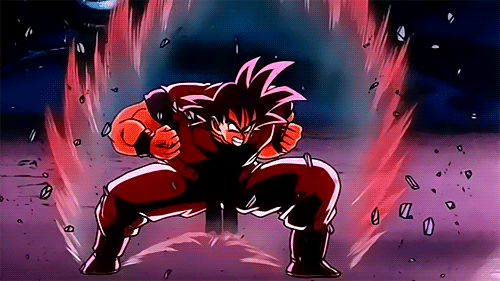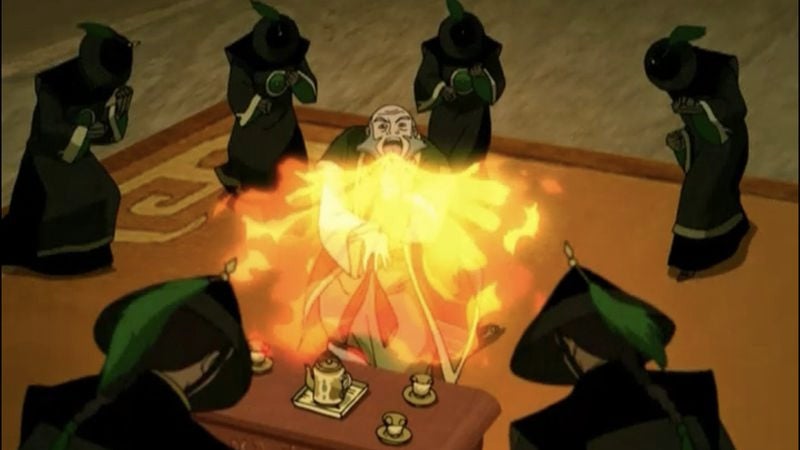Merry Fistmas everybody! Let's hope super-ripped Santa-Ken smashes his way through your free-standing brick walls and stuffs your stocking with VIOLENCE on this jolliest of all occasions/attacks!
 |
| A Merry Fistmas to all, and to all a good fight! |
To start the festivities, I've got a special treat for you all; this little elf has been busily completing the Lone Wolf Fists playtest! As one of our capstone pieces of writing, I present the long-awaited Content rules, so you can prep and run stuff for your very own post-apocalypse!
...
Horizontal Content
When players go someplace new, what’s there? Who’s there? What are they doing? Horizontal Content answers this question. When players kick down a door, it tells them what’s in the room.
Elements of Horizontal Content
The Map
As the GM, you’ll need to keep in mind the spatial relationship of different places to one another: that’s where a map comes in handy! This map is only a rough approximation of your game’s world; it shows direction and relative size of areas, for your quick and convenient consultation.
As with your other notes, this map generally isn’t shared with players; the exploration that happens in their imaginations, from your description of the environment, will always be superior to even the most detailed map.
The Key
The descriptions, inhabitants, and other things present in the areas of the of map are all described under the numbered Key. It’s a lot easier to show than tell you how this works:
- Mountain Pass
- Narrow Defile
- Stone Wall
- Stone Fort
- Training Ground
- Wider Pass
- Hidden Caves
- Jungle Entrance
The picture on the left is the map, showing the rough shape, relative size, and spatial relationship of the areas. The Key on the right names the numbered areas of the map. In the full key, these names would additionally contain descriptions of those areas and their inhabitants, contents, and any special notes that you need to remember.
Elements of the Key
The key is designed to tell you what’s in a place, how it looks, who’s there, and what they’re doing. It does this with the following entries:
Description: A brief rundown of everything a character sees when they’re looking around the area.
Elements and Hazards: Things that are present; buildings, flows of lava, trees, radioactive graveyards; whatever’s there.
Inhabitants: The people and creatures in the area.
Status Quo: The typical state of affairs in the area.
Notes: Anything else you need to know.
Let’s go through each in turn.
Description
This entry gives you, the GM, a quick rundown of what’s in an area and why. If there’s something you need to know about this entry, you’ll find it here. The writing blends a description of the area with that of its inhabitants, their motivations, and anything else routinely present and why.
This sometimes includes what a character’s senses immediately tell them about an area. What characters see (or don’t in the case of inky blackness) is always listed; otherwise only the most notable elements are are described. Sometimes these act as a clue to draw a player to further investigate. “Smells sepulchral, like an hot slaughterhouse” is a shocking statement about a temple filled with smiling priests!
The descriptions are deliberately brief: you’ll be reading them in-play a lot of times, so they’ve got to be punchy! These aren’t meant to be read aloud: they’re just quick notes for your to skim to inform your own descriptions.
And besides, you know what “A dirty kitchen” or “A patch of shimmering desert sand” looks like, and if you’re spouting a small novel’s worth of tedious narration every time players turn a corner, they’ll swiftly begin to tune it out.
Elements and Hazards
Since this is a game about acrobatic combat, any notable pieces of scenery are described in game-terms as Elements or Hazards under this entry. Sometimes their placement is very specific, but other times this is closer to a shopping-list of stuff you can use to create ad-hoc battlefields if a fight breaks out here.
Inhabitants
Although they’re described under the Description entry first, notable inhabitants often need a deeper dive to describe both their rules and their motivations for being present. This is where you’ll find all of that lovely information.
Status Quo
The world of your game is always in motion; its inhabitants don’t stand still, waiting for the player’s characters to show up. They live their lives, scavenging and fighting, making allies and enemies, raising children, gathering food, and everything else you imagine they might do in the post-apocalypse.
If the area is safe and relatively stable, people tend to fall into patterns of behavior; they’re not frozen in time, just generally involved in the same activities on a day-to-day basis. This state of repeating stability is called a Status Quo (“The state in which”), essentially the expected state of affairs in a given place.
Areas are generally in their Status Quo: when players go there, whatever activities are described under the entry is going on. This isn’t universal; a weapon shop’s Status Quo might be to be open for business and bustling with patrons, but if the characters arrive after-hours it’ll be empty. The Status Quo describes the most common and most iconic activities of a location.
Even if shaken up, things tend to return to the status quo. Having a fight in a marketplace certainly disrupts business during the conflict, but after the excitement dies down, the shops open up and customers flood back in.
Really big disruptions can change this; we’ll talk about that in a little bit.
Notes
All the information you’ll need as a GM sometimes doesn’t fit completely in the neat categories we have here; if we need to cram just a little more info in, you’ll find it here. Among other things, you’ll often find bad-guy battle tactics and treasures listed under this heading.
Elements of the Key
The key is designed to tell you what’s in a place, how it looks, who’s there, and what they’re doing. It does this with the following entries:
Description: A brief rundown of everything a character sees when they’re looking around the area.
Elements and Hazards: Things that are present; buildings, flows of lava, trees, radioactive graveyards; whatever’s there.
Inhabitants: The people and creatures in the area.
Status Quo: The typical state of affairs in the area.
Notes: Anything else you need to know.
Let’s go through each in turn.
Description
This entry gives you, the GM, a quick rundown of what’s in an area and why. If there’s something you need to know about this entry, you’ll find it here. The writing blends a description of the area with that of its inhabitants, their motivations, and anything else routinely present and why.
This sometimes includes what a character’s senses immediately tell them about an area. What characters see (or don’t in the case of inky blackness) is always listed; otherwise only the most notable elements are are described. Sometimes these act as a clue to draw a player to further investigate. “Smells sepulchral, like an hot slaughterhouse” is a shocking statement about a temple filled with smiling priests!
The descriptions are deliberately brief: you’ll be reading them in-play a lot of times, so they’ve got to be punchy! These aren’t meant to be read aloud: they’re just quick notes for your to skim to inform your own descriptions.
And besides, you know what “A dirty kitchen” or “A patch of shimmering desert sand” looks like, and if you’re spouting a small novel’s worth of tedious narration every time players turn a corner, they’ll swiftly begin to tune it out.
Elements and Hazards
Since this is a game about acrobatic combat, any notable pieces of scenery are described in game-terms as Elements or Hazards under this entry. Sometimes their placement is very specific, but other times this is closer to a shopping-list of stuff you can use to create ad-hoc battlefields if a fight breaks out here.
Inhabitants
Although they’re described under the Description entry first, notable inhabitants often need a deeper dive to describe both their rules and their motivations for being present. This is where you’ll find all of that lovely information.
Status Quo
The world of your game is always in motion; its inhabitants don’t stand still, waiting for the player’s characters to show up. They live their lives, scavenging and fighting, making allies and enemies, raising children, gathering food, and everything else you imagine they might do in the post-apocalypse.
If the area is safe and relatively stable, people tend to fall into patterns of behavior; they’re not frozen in time, just generally involved in the same activities on a day-to-day basis. This state of repeating stability is called a Status Quo (“The state in which”), essentially the expected state of affairs in a given place.
Areas are generally in their Status Quo: when players go there, whatever activities are described under the entry is going on. This isn’t universal; a weapon shop’s Status Quo might be to be open for business and bustling with patrons, but if the characters arrive after-hours it’ll be empty. The Status Quo describes the most common and most iconic activities of a location.
Even if shaken up, things tend to return to the status quo. Having a fight in a marketplace certainly disrupts business during the conflict, but after the excitement dies down, the shops open up and customers flood back in.
Really big disruptions can change this; we’ll talk about that in a little bit.
Notes
All the information you’ll need as a GM sometimes doesn’t fit completely in the neat categories we have here; if we need to cram just a little more info in, you’ll find it here. Among other things, you’ll often find bad-guy battle tactics and treasures listed under this heading.
Vertical Content
When players start asking questions about a new place they’ve encountered, how do you answer them? How do you know what motivates an NPC? Or how people react when confronted with the players (or the inevitable violence that trails in their wake)? What situation have the players stumbled into, and how can they turn it to their advantage?
Vertical Content answers this question. When they players ask “Why?”, this gets them an answer.
Elements of Vertical Content
The Elephant Board: A map of an abstract situation, plot, or intrigue.
Phases: The steps a plot goes through as it resolves
The Elephant Board: Mapping intrigue, conspiracies, and situations
Players explore courtly intrigue alongside the courts; they go “deeper” or “higher” into plots and dramas, hence “Vertical”. Although situations aren’t concretely and permanently linked to a physical space, we can still map them after a fashion.
Much like the physical map, the Elephant Board is a rough approximation. But rather than mapping locations, it’s a map of the world’s situations.
Elements of the Elephant Board
Anchors: Clues, places, and characters present in Horizontal Content that act as doorways to an Elephant Board
Squares: Scenes on the Elephant Board, arranged in space and time
Connections: The characters and clues that relate the plot together, allowing movement between the Squares of the Elephant board
Dynamic Content: The movement of content from the Status Quo to a different set of events.
Resolution: The number of Montage Scenes that a Square’s events require before they resolve. Once every Square in a Phase resolves, the plot advances to the next Phase.
Consequences: What events come to pass if the players don’t interfere
The Elephant Board is a somewhat more malleable and less concrete set-up than our more traditional map; it’s useful in that it allows you a lot of flexibility to create dynamic, unique situations, but also an obstacle, because it’s difficult to intuit exactly what each part represents.
To give you a brief rundown: it has boxes, called Squares (like squares on a game board) that represent situations with Connections that represent clues that allow “movement” between them. The Squares are linked to Horizontal Content by Anchors in the game world. The events in the Squares are Dynamic Content and resolve if players don’t interfere; the amount of time this takes is determined by its Resolution. If an entire plot resolves, then it’s Consequences manifest in the game’s world to bedevil the players.
Here’s an example, so you can get the gist of the thing:
Here we see an example Elephant Board plot; a nefarious plan by a trusted but evil-hearted member of the Golden Lion faction, orchestrating a scheme to slay a rival by betraying them in a war with the Shadow Vipers.
Each of these Squares is a Scene; the Anchors tell you where it takes place, what characters are involved with it, and what they’re trying to accomplish. Since scenes aren’t static places on a map, they take place within the conceptual map of an Elephant board. Because of this, they have time dimension lacking in Horizontal Content.
Dynamic Content
A powerful difference between maps and the Elephant Board; the points of a map remain essentially forever (Iron Skin Mountain isn’t likely to pick itself up and go anywhere!) but the points of the Elephant Board are in motion, constantly moving to seek a conclusion. This makes them Dynamic Content.
Think of Dynamic Content as the opposite of the Status Quo. Where the Status Quo makes activities return to a pattern, Dynamic Content forces activities to change.
The Squares of the Elephant Board amend the Status Quo of a location; instead of, or in addition to, the activities detailed in the Status Quo, the activities described on the Square transpire as well.
How long do these activities last? Each Square describes the number of scenes that it lasts in it’s Resolution entry; these may be experienced by players, but might pass while they spend scenes traveling, training, or or otherwise occupied. The type of scene defaults to Montage when players aren’t interacting with them, but is of an appropriate type when they are.
Note the Phases of this Elephant Board are arranged in a rough chronological order (the “steps” to the left of the boxes). Every event detailed within a Square must transpire before the scheme “moves” to the next Phase.
Anchors
What links the points on the Elephant Board to the world the player’s characters inhabit? The answer is simpler than you’d think; Squares are connected to Horizontal Content by clues and characters called Anchors.
Anchors are things already keyed to Horizontal Content: If the players go to Turtle Providence, they will see Golden Lion soldiers recruiting the populace. If they find themselves in Garbage Town, the munitions plant will be running. If they go snooping around Iron Heart Riku’s home, they’ll likely find an incriminating letter from the mastermind behind this plot.
The recruiting soldiers, factory workers, and letter are all Anchors; they’re things keyed to a patch of Horizontal Content that act as clues to get the players investigating the Betrayer’s Plot.
Connections: Moving on the Elephant Board
What connects the Squares of an Elephant Board to one another? And how can players move between them to investigate and thwart it’s plot?
To answer this, let’s return to Garbage Town; the smoke rising from the formerly dormant factory is an Anchor, a clue that some event is transpiring there; following that clue by going to investigate is similar to entering a room by going through a doorway. It “lets you into” the Square: you enter the factory, where scavengers are being press-ganged into workers, creating weapons.
Connections let you keep following that trail: the clues and characters within the Squares act as directions and doorways between them.
One Connections is where the weapons are going: following the weapons along to the army being raised in Turtle Providence connects the players to the Turtle Providence Square ( a lateral move).
Another is who ordered the weapons made in the first place: the players might move downward to the next phase, following the chain of command back to the plots of the scheming warrior and find out what else he’s up to.
Note, this also means that characters can get ahead of the plot; if they investigate this scheme before it comes to fruition, they can trounce the mastermind behind it before it even gets to Phase 2!
Refusing the call
What if the players find the whole affair below their notice? Players are notorious for ignoring the schemes of nefarious NPCs.
The world needs the intervention of heroes; if the players do nothing, then the scenes they choose not to engage with pass, and the villain’s plan continues creeping closer to completion.
When all the scenes called for in the Conclusion of a Square come to pass, it’s described event comes to pass. If all the Squares in a Phase (one of the tiers of the Elephant Board) resolve, the next Phase begins.
If all of the Phases resolve, then the Consequence comes to pass. This is what happens when the players fail to stop the machinations of evil men; armies and heroes are slain, civilizations burn to the ground, and the forces of destruction grow ever stronger.
Sequential and Concurrent Events
Squares on the same Phase with nothing in common can resolve simultaneously; The factories in Garbage Town can run as soldiers recruit in Iron Turtle, while an enticing offer is sent to Iron-Heart Riku. A sufficiently organized plotter can resolve all these schemes Concurrently and move up to the next Phase of their plot.
However, if any places, characters or other elements are shared between points, they must resolve Sequentially, one after the other. This makes sense; Iron-Heart Riku can’t simultaneously be tempted to lead an army and lead it into battle; he’s got to be swayed first, then he can show up on the battlefield.
Kicking off, moving and stalling plots
When do you put an Elephant Board’s plot into motion? The best time is when players start interacting with it; once they go to Garbage Town and see smoke rising from it’s long-dormant factory, it’s fair game to assume the plot is afoot and starting counting down scenes until it advances.
Players might investigate and get clues that lead them around the plot; as they spend scenes digging into the wicked plans, simply track any full Montage scenes that pass and move the plot along with the players. This gives the impression of a dynamic situation, and puts a time limit on their investigation.
The default assumption is that the clock starts ticking on a piece of Vertical Content as soon as the players interact with any of it’s Anchors. Of course, you’re under no obligation to further the plot immediately: even the best-laid plans have snags, and it’s completely reasonable to choose not to advance a plot that doesn’t hold any immediate relevance to players.
If the players don’t take the bait and you want to let it wait, you have the right to stall it out until they come back to it.
With such “”stalled content”, it’s fair to simply leave it the way the players found it until (or if!) they ever return to investigating it. It’s also reasonable to advance it a step or more if they take a long time in getting back to it.
You can even declare the whole thing a wash and simply re-cast the whole thing with fresh characters and whatever changes you like. The goal of Vertical Content is to give the players a way to get involved with the ongoing events of the world; if they abandon that chance, you can alter things however you see fit to uphold this goal.
Orthogonal Content
The world isn’t as static as our nice, clean maps would indicate; it’s a basket of snakes, squirming and moving ceaselessly as the players interact with it.
To simulate a living, breathing world of adventure, this game mixes up the elements from the other two varieties of content and delivers it randomly to the players by way of Orthogonal Content.
Elements of Orthogonal Content
Encounter Chart: a list consisting of the most interesting inhabitants and events transpiring in an area. Typically keyed to a Domain.
Threshold: The number of turns the players can take within a scene before Orthogonal Content is triggered
Activity: A number between 1-10 representing how busy a place is. Typically keyed to Tracts.
Triggering Orthogonal Content
Characters travel, events spill out of their borders, and monstrous creatures hunt far from their dens. To simulate these complicated patterns of behavior, when players explore and investigate the Content within a Domain, they risk encountering some of it wandering away from where it’s keyed.
Every time players:
They risk triggering Orthogonal Content.
The Triggering roll: Activity
How likely is it that characters encounter something? That depends on a lot of factors which would be a migraine to track: patterns of movement, urges, opportunities, traffic density, etc. etc.
Rather than create a detailed map of that mess, we assign a number between 1-10 to the overall density of movement and population called Activity. A low number represents sparse movement and few inhabitants, while a high number represent a large population or high volume of traffic.
When Orthogonal Content is triggered, secretly roll a single d10 and compare it to the Activity score of the area the players currently inhabit: if it is equal to or lower than the score, then something is encountered!
Threshold
Another dimension of encounter density is the Threshold. When players are taking actions in a Real-Time scene, check for an encounter every time this number of rounds of activity conclude. Busier, fuller areas have a lower Threshold, while sparsely populated places have a higher one.
Encounter Charts
But what is encountered? That depends on what’s populating the Encounter Chart of that Domain. Roll a d100 (two d10s; the leftmost is the “tens” and the rightmost is the “ones”, 000 is one-hundred) in secret and consult the Domain’s Encounter Chart: cross-reference your roll’s result with the chart to determine what the players run into.
An example chart is listed below:
1-20 Waste Mutants
21-40 Hunting outland Barbarians
41-50 Escaped genetic experiments
51-60 Traveling fortune teller
61-75 Corpses of any of the above
76-90 Eerie blue-skinned dwarf (Black Talon)
90-100 Broken-down vehicle
Building the Encounter Charts
Creatures don’t apparate out of thin air; they come from somewhere and there’s a reason they’re moving around.
A Domain’s Encounter Chart is built out of it’s Horizontal and Vertical Content.
Every character, group or other mobile element present in the Horizontal or Vertical Content has an entry on the Encounter Chart. The range which encounters them roughly corresponds to how active or populous the entries are compared with one another.
Note: there’s no formula for this. Just eyeball it when making your own.
What happens in an encounter?
Bumping into a wandering villain doesn’t have to result in a fight; it’s sometimes more interesting if it doesn’t! There are a few ways you can resolve Orthogonal encounters:
- Power Up
- Begin a Montage scene
- Move between areas of Horizontal Content
- Enter a new Square of Vertical Content or
- Take an area’s Threshold of turns during a scene
They risk triggering Orthogonal Content.
The Triggering roll: Activity
How likely is it that characters encounter something? That depends on a lot of factors which would be a migraine to track: patterns of movement, urges, opportunities, traffic density, etc. etc.
Rather than create a detailed map of that mess, we assign a number between 1-10 to the overall density of movement and population called Activity. A low number represents sparse movement and few inhabitants, while a high number represent a large population or high volume of traffic.
When Orthogonal Content is triggered, secretly roll a single d10 and compare it to the Activity score of the area the players currently inhabit: if it is equal to or lower than the score, then something is encountered!
Threshold
Another dimension of encounter density is the Threshold. When players are taking actions in a Real-Time scene, check for an encounter every time this number of rounds of activity conclude. Busier, fuller areas have a lower Threshold, while sparsely populated places have a higher one.
Encounter Charts
But what is encountered? That depends on what’s populating the Encounter Chart of that Domain. Roll a d100 (two d10s; the leftmost is the “tens” and the rightmost is the “ones”, 000 is one-hundred) in secret and consult the Domain’s Encounter Chart: cross-reference your roll’s result with the chart to determine what the players run into.
An example chart is listed below:
1-20 Waste Mutants
21-40 Hunting outland Barbarians
41-50 Escaped genetic experiments
51-60 Traveling fortune teller
61-75 Corpses of any of the above
76-90 Eerie blue-skinned dwarf (Black Talon)
90-100 Broken-down vehicle
Building the Encounter Charts
Creatures don’t apparate out of thin air; they come from somewhere and there’s a reason they’re moving around.
A Domain’s Encounter Chart is built out of it’s Horizontal and Vertical Content.
Every character, group or other mobile element present in the Horizontal or Vertical Content has an entry on the Encounter Chart. The range which encounters them roughly corresponds to how active or populous the entries are compared with one another.
Note: there’s no formula for this. Just eyeball it when making your own.
What happens in an encounter?
Bumping into a wandering villain doesn’t have to result in a fight; it’s sometimes more interesting if it doesn’t! There are a few ways you can resolve Orthogonal encounters:
- If you’ve got a great idea for why this person/creature is in this place, go with your instinct! These encounters are an outstanding opportunity to show off your spontaneous creativity.
- If you’re less certain or don’t have any ideas that really grab you, consider linking the purpose of the encounter to the Status Quo or Dynamic element of the Content that spawned it; this gives it a mission, and a reason to be in the scene.
- Finally, if you have no idea what they’re doing, assume that they’re lost, seperated, confused, having a moment of introspection/doubt, or otherwise behaving radically out of character
For that last point, it’s sometimes useful to have a chart of reasons for out-of-character behavior, like this one right here:
Why is this person here?
Roll a d10
- They’re meeting a friend or lover
- They’re blowing off steam; something about their situation got under their skin
- They’re on vacation
- They’re dunk, on drugs, or having a psychotic episode
- They’re following a prophecy that they’ll meet the PCs in this place, around this time
- They’ve trying to collect a bounty on the PC’s heads
- They’ve got a bounty on their head, and they’re desperate for some help
- They’ve been disowned, and are on the hunt for allies to help them take vengeance/give them a new life
- They’ve heard a rumor the PCs are in the area, and they’re huge fans/foes of theirs
- They’re looking for a new kung-fu master to teach them

